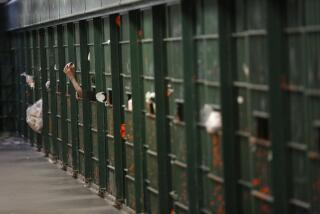Op-Ed: L.A. County needs to construct mental health programs, not just jails
- Share via
For decades, the county has spent untold amounts of public money to warehouse people with mental illnesses in the Los Angeles County jail. This costly and ineffective approach has resulted in sky-high recidivism rates and increased crime.
Now, the Los Angeles County Board of Supervisors is considering a proposal to spend as much as $2.3 billion on a massive jail expansion, with a significant portion of that money going to facilities for mentally ill inmates, who currently make up nearly 20% of the jail population.
The supervisors are right that something should change. The U.S. Department of Justice has condemned the treatment provided to inmates with mental illness in L.A. jails. These inmates cycle in and out of lockups, often for petty violations related to their mental illnesses. But building a massive new “treatment jail” is the wrong approach to solving the problem.
As a Los Angeles County Superior Court judge with more than 31 years on the criminal bench, I am all too familiar with what happens when people with serious mental illness get caught up in the criminal justice system. I have seen firsthand that jail is an inappropriate place for many of the mentally ill defendants who end up there. Being incarcerated is likely to exacerbate mental health problems and to increase the likelihood that inmates will commit new crimes upon their release.
Instead of spending large amounts on a better jail experience for them, we should spend money on local treatment programs that would keep low-risk offenders with mental illness out of jail.
The vast majority of the mentally ill defendants who appear before me have been charged with low-level nonviolent felonies such as repetitive thefts or simple drug possession, and my goal is generally to try to place them in appropriate mental health programs as a condition of probation. But this has become increasingly difficult because of a shrinking number of treatment slots.
If Los Angeles County would use some portion of the billions of dollars it would cost to expand and operate a new facility for mentally ill inmates to instead fund a diversion program, our job would be much easier. Instead of laboring for months to find or wait for a suitable placement, we could place mentally ill prisoners quickly, obviating the need for counter-therapeutic incarceration that can drag on for months. Extended incarceration under such circumstances is not only damaging to the mentally ill, it is extraordinarily expensive.
Supporters of a new facility note that current conditions in Men’s Central Jail are inhumane for people with mental illness. Moreover, the jail is crumbling and inefficient. These things are true, and when a new jail is built, there probably will be a need for the county to build a modest facility to house inmates with mental illness, since some small minority of them do require locked, hospital-like facilities. But their numbers do not warrant the enormous project that has been proposed.
Each of the options before the supervisors provides for housing the same number of mentally ill inmates in the jail as are currently housed there: more than 3,000. A substantial portion of the mentally ill within the county jail system, people I see in my courtroom every day, do not need and would not benefit from the large and expensive alternatives proposed in all of the new jail plans.
The experience of other counties across the country demonstrates that treatment outside penal institutions is not only vastly cheaper but also a far more effective approach to dealing with mental illness. For example, in Florida’s Miami-Dade County, a misdemeanor diversion program reduced the recidivism rate from 75% to 20%. And a felony diversion program was even more effective, cutting the recidivism rate to a mere 6%.
San Francisco County also has had great success with its diversion program. A study found that people enrolled in the program were 26% less likely to be charged with a new crime and 55% less likely to commit a new violent crime than people who did not take part in the program.
Los Angeles County should adopt this evidence-based approach and expand mental health programs instead of building 3,000 new mental health jail beds. Before embracing massive new jail construction, the supervisors should pause and figure out the right balance between diversion and incarceration, and plan its construction accordingly. This is not just a matter of sound mental health and criminal justice policy, it is also a matter of fiscal responsibility.
Terry Smerling is a judge on the Los Angeles County Superior Court.
More to Read
A cure for the common opinion
Get thought-provoking perspectives with our weekly newsletter.
You may occasionally receive promotional content from the Los Angeles Times.










